|
|
|
Sort Order |
|
|
|
Items / Page
|
|
|
|
|
|
|
| Srl | Item |
| 1 |
ID:
170702
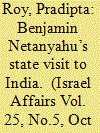

|
|
|
|
|
| Summary/Abstract |
A six-day visit by PM Benjamin Netanyahu to India on 14–19 January 2018 marked a new apogee in the renewed relationship between two old civilizations. It was a reciprocal visit to PM Narendra Modi’s visit to Israel in July 2017 to celebrate the Silver Jubilee year of the ‘Diplomatic Normalisation’ between the two states. Netanyahu’s visit took place not only against the backdrop of this enthusiasm, but also had concrete economic and political goals given that just a month before the visit New Delhi cancelled a $500 arms deal with Israel and voted against the Jewish state in the UNGA on the Jerusalem question. Through five public addresses, three media interviews and one road show, Netanyahu attempted to break longstanding anti-Israel stereotypes and show the Indian masses that they could be beneficiaries of Israel’s innovation and technological advancement. Amplified by a string of economic, high-tech, agricultural, and defence agreements, Netanyahu’s visit proved to be a success, whose positive implications will affect the bilateral relations for years to come.
|
|
|
|
|
|
|
|
|
|
|
|
|
|
|
|
| 2 |
ID:
170707
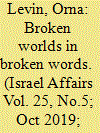

|
|
|
|
|
| Summary/Abstract |
This article addresses an unstudied literary discourse pattern in Israeli literature, which it terms an ‘empty discourse’ on Israeli wars, suggesting that they have become a simultaneously absent and present theme in Israeli literature. The analysis is based on Wittgenstein’s philosophy of language, which serves to explain the mutual influence between the reality of war and war literature. Based on the literary analysis presented, the article suggests a wider typology for examining this issue in contemporary Israeli literature published after the 2006 Lebanon War.
|
|
|
|
|
|
|
|
|
|
|
|
|
|
|
|
| 3 |
ID:
170701
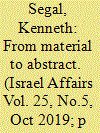

|
|
|
|
|
| Summary/Abstract |
Design anthropology has developed to become an influential sub-discipline occupied with both theoretical and applied knowledge targeted at designers’ real-life challenges. Bearing this in mind, in the last decade we have developed this attitude into a methodology centered around the identification and development of ‘cultural objects’ that can be implemented with insight and understanding within a conventional design process. This methodology isolates and magnifies the cultural aspects of objects and harnesses these to design new hybrid objects that reinterpret and translate cultural values and characteristics into a local context. This paper presents one of the various approaches dealing with the interpretation of philosophic, religious or socio-cultural principles of different cultures through an Israeli designer’s eyes. In this case the re-interpretation of Japanese, African or American cultures of wood and materializing various cultural traits led the students to an intricate and meaningful design process. From the results we recognized two points of significance: understanding that designing and researching through the isolation of a specific material (i.e., wood), the anthropological design process is crystalized and produces profound results that are culturally centered; the second was an insight into how young Israeli designers presented a unique and innovative approach towards contemporary Israeli design through the culture of wood.
|
|
|
|
|
|
|
|
|
|
|
|
|
|
|
|
| 4 |
ID:
170706


|
|
|
|
|
| Summary/Abstract |
his cross-sectional study examines changes in the importance of the valued work outcomes among Israeli men and women aged 25 years and over. Overall, gender differences have been declining over the years. Moreover, among both women and men there was decrease in the importance of the intrinsic outcome of interest and the social outcome of serving society at the expense of the dramatic increase in the importance of the extrinsic outcome of income. These trends reflect a continuing transformation from a more collectivist and altruistic society to a more individualistic and materialistic society.
|
|
|
|
|
|
|
|
|
|
|
|
|
|
|
|
| 5 |
ID:
170703


|
|
|
|
|
| Summary/Abstract |
Over the past decade (2006–18), a number of Israelis from Iranian background initiated Civilian Relations Building Initiatives (CRBIs) dedicated at bridging the divide with the Iranian people and help in preventing war between Israel and Iran. They mostly use information technologies (IT), including social media and radio platforms, to connect with the Iranians and have been successful at gaining such an Iranian audience. Given the important role that such CRBIs could play in defusing the growing Israeli-Iranian tensions, this pioneering study aims at evaluating how effective these CRBIs have been and analyze the obstacles they confront.
|
|
|
|
|
|
|
|
|
|
|
|
|
|
|
|
| 6 |
ID:
170704
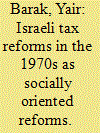

|
|
|
|
|
| Summary/Abstract |
The income tax reform in Israel that was introduced in August 1975 bridged two ostensible objectives: the enlargement of levying and the provision of a redistributive mechanism. In other words, it aimed to establish a system that would simultaneously achieve economic efficiency and social justice. The reform was unique since it invented an original Credit Points mechanism that linked together efficiency and distributive justice.
Introducing the Value Added Tax a year later was also justified as an indirect progressive tax that could be related to as a business tax rather than as an expenditure tax, levied directly on customers. One of the main concerns of the leading academic economists during that period was the enlarged socio-economic gap. Hence, the two tax reforms were also justified by pro-social arguments.
|
|
|
Key Words
|
Economists
;
Direct taxation
;
Military Burden
;
VAT
;
Tax Burden
;
Credit points, direct tax reform, economists, family grants, inequality, Israbluff, military burden, tax burden, social gap, VAT,
|
|
|
|
|
|
|
|
|
|
|
|
|
|
| 7 |
ID:
170705
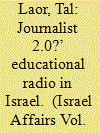

|
|
|
|
|
| Summary/Abstract |
Educational radio stations in Israel, which have operated for at least 25 years, are inspired by the American college radio. This article investigated the functions and contributions of radio to students and to the media industry in general and radio broadcasts in particular. A research survey was distributed on aspects of the media industry and interviews with educational radio activists were conducted. The findings indicate that schools of communication believe and invest in integrating practical experience. As a result, students acquire abilities and practical skills as well as knowledge of the communications world. Students operate educational radio stations with high levels of motivation and self-fulfillment. These student efforts and support from academic institutions bear fruit as the media industry acknowledges the value of educational radio studies graduates and appreciates their preparedness to integrate into the industry.
|
|
|
|
|
|
|
|
|
|
|
|
|
|
|
|
| 8 |
ID:
170700


|
|
|
|
|
| Summary/Abstract |
This article examines the processes of selecting human figures on banknotes since the establishment of the State of Israel in 1948. Given Israel’s relative youth, along with the permission to read all proceedings and correspondence of the Bank of Israel Banknotes and Coinage Planning Committee from its inception in 1955 to 2012, we will decipher the selection of 33 human figures and the ideological motivations behind it. We will contextualize the discussions of the committee in Israeli social and political history; explain the belated, 1969, selection of human figures for illustrations on banknotes; depict the ideological outline of the committee; assess its level of independence; and reveal the working dynamics of a hegemonic body that is compelled to reflect the central personas of a society in the process of founding and institutionalizing a nation state – in this case, the State of Israel.
|
|
|
|
|
|
|
|
|
|
|
|
|
|
|
|
|
|
|
|
|